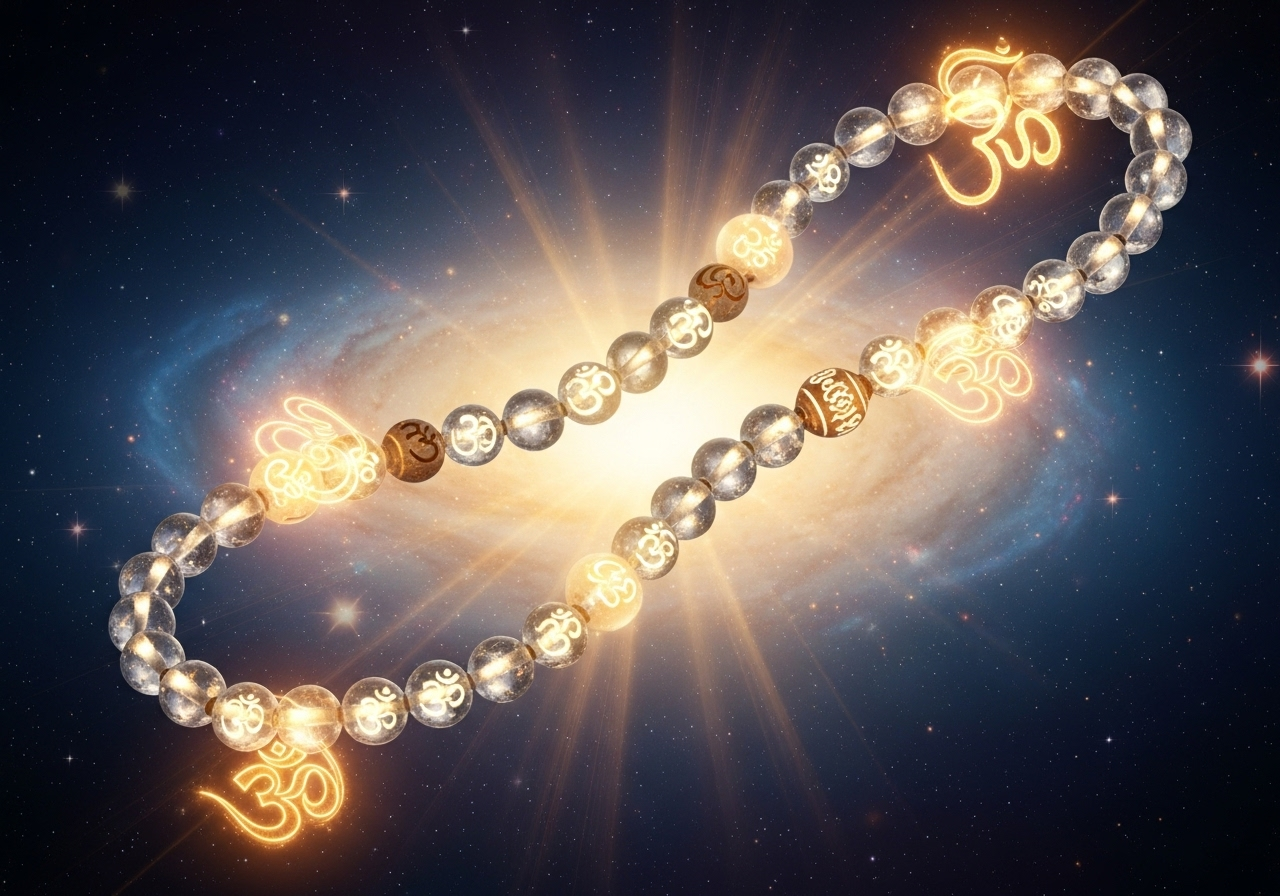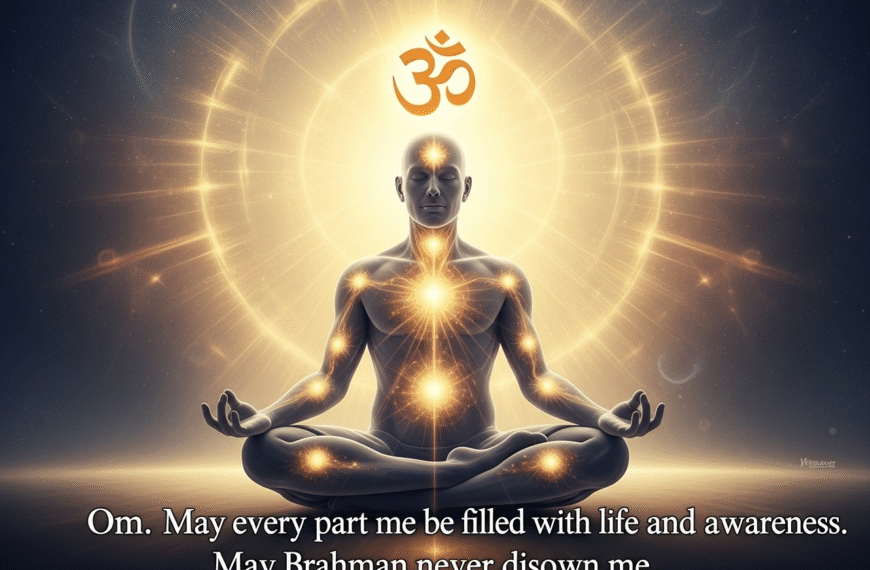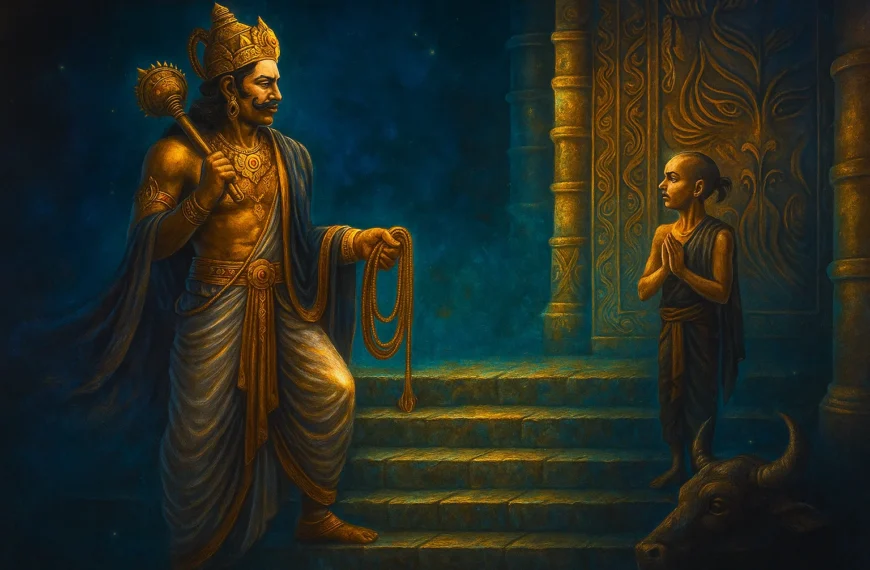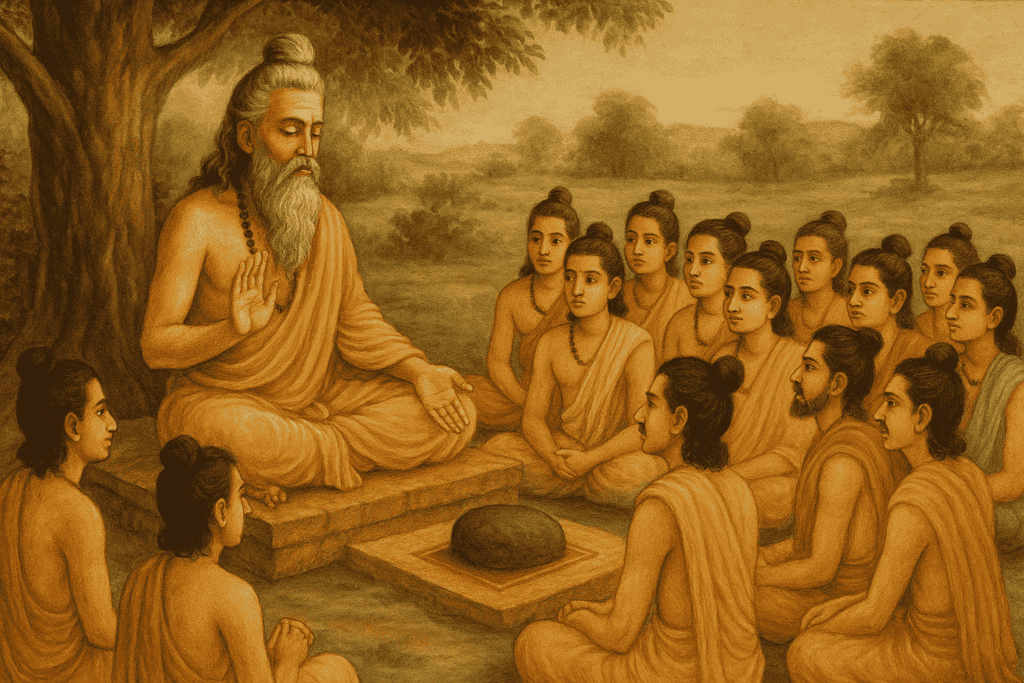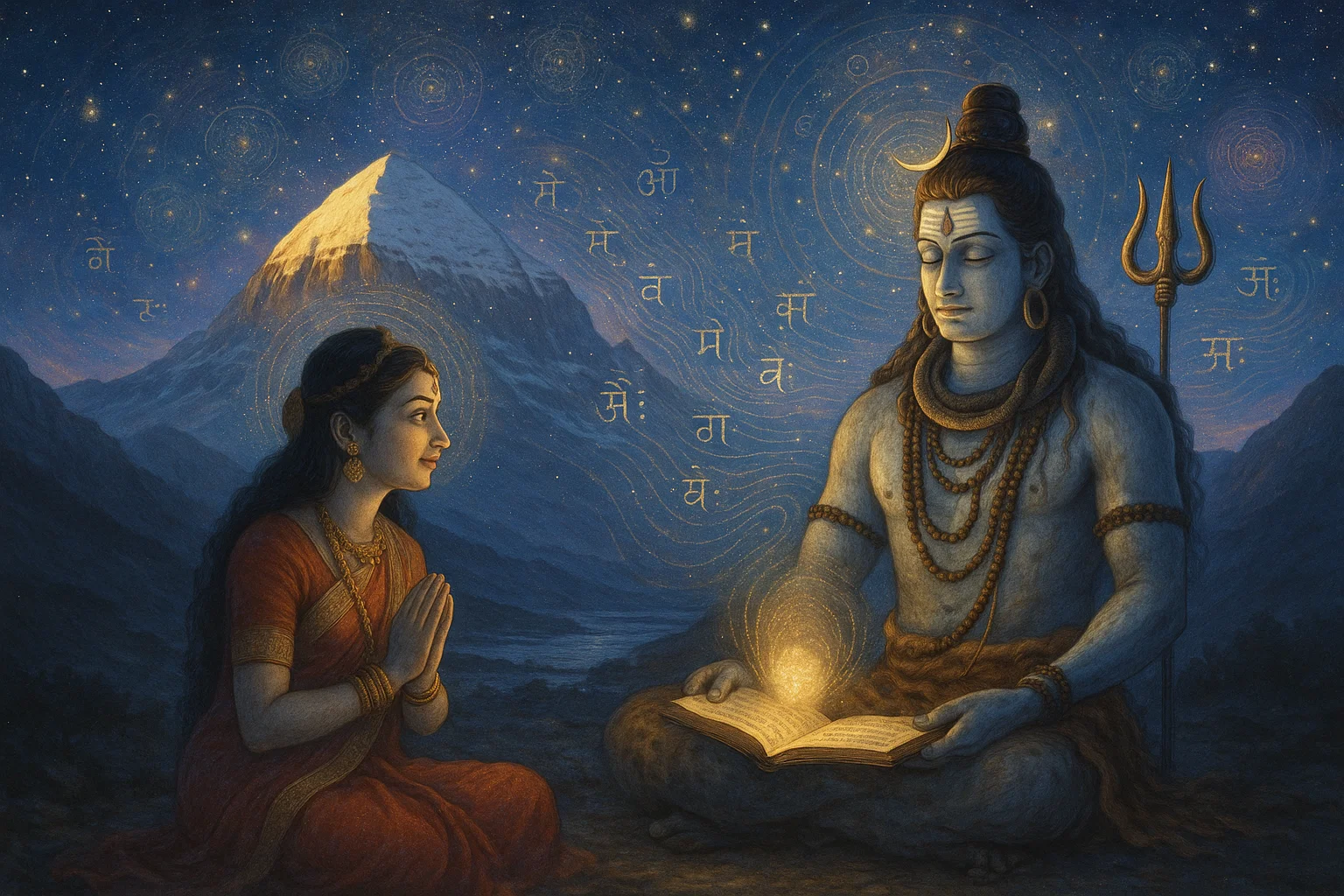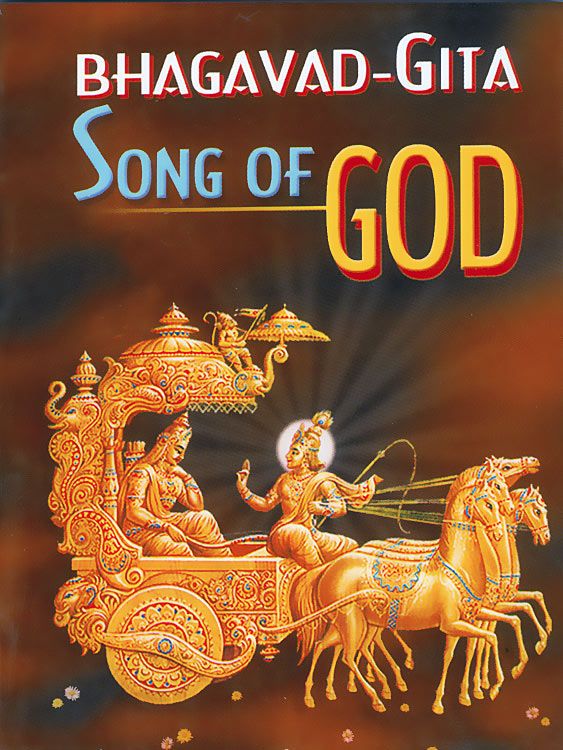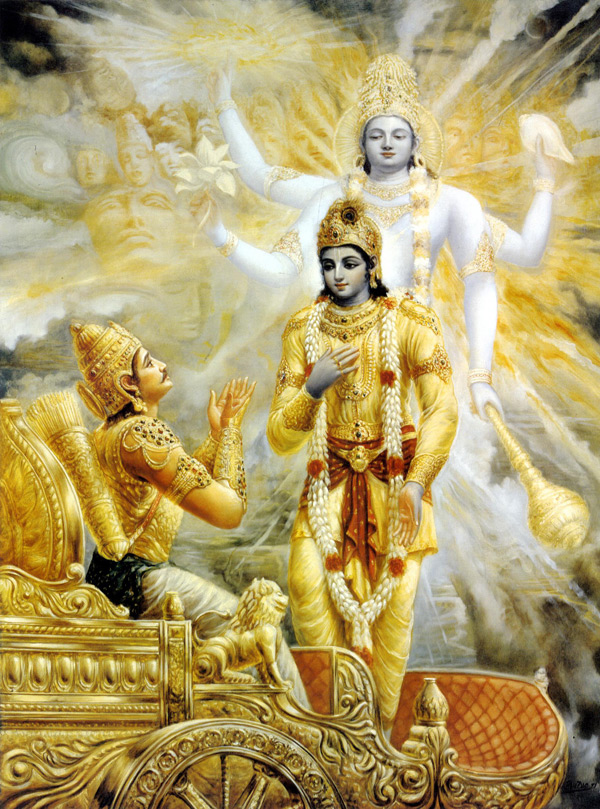The ancient wisdom traditions, in their profound contemplation of existence, often distill vast cosmic truths into tangible symbols and practices. The Aksha Malika Upanishad, the “Upanishad of Rosary Beads,” is one such luminous text, inviting us to look beyond the ordinary and perceive the sacred tapestry woven into the very fabric of our lives, even in something as seemingly simple as a string of beads. It guides us into a deeper understanding of intention, sound, and the interconnectedness of all things, making the mundane a gateway to the divine.
Let us begin with the timeless invocation that opens and closes this sacred text—a universal prayer for harmony and alignment, resonating with the deepest aspirations of the human heart, regardless of origin:
“Om! May my speech be based on (i.e. accord with) the mind;”
This profound prayer seeks a perfect congruence between our inner thoughts and our outward expressions, aspiring for a state where every word spoken is a pure reflection of the mind’s true intention, fostering authenticity and integrity in communication.
“May my mind be based on speech.”
Conversely, it asks that our mental landscape be shaped and purified by our conscious and truthful verbalizations, recognizing the powerful feedback loop where our uttered words can profoundly influence and clarify our internal state, encouraging mindfulness in every thought.
“O Self-effulgent One, reveal Thyself to me.”
This is a heartfelt plea for the manifestation of the inner light, the divine consciousness residing within each being, a universal yearning for self-realization and the unveiling of one’s truest, most radiant nature.
“May you both (speech and mind) be the carriers of the Veda to me.”
Here, “the Veda” signifies timeless wisdom, universal spiritual knowledge, and profound truths; the prayer is for both thought and word to become clear conduits, allowing this sacred, liberating understanding to flow freely into one’s being and guide one’s existence.
“May not all that I have heard depart from me.”
This expresses a deep desire for the retention of wisdom, not merely as intellectual information, but as embodied understanding that becomes an intrinsic part of one’s spiritual fabric, preventing the ephemeral loss of profound insights gained.
“I shall join together (i.e. obliterate the difference of) day And night through this study.”
This speaks to an unwavering commitment to spiritual pursuit, transcending the conventional boundaries of time and the cycles of worldly activity; it signifies a continuous, unbroken state of meditative awareness, where the spiritual journey is seamlessly integrated into every moment, day and night.
“I shall utter what is verbally true;”
It sets a clear intention for truthfulness in all spoken words, aligning external expression with the highest principle of honesty and sincerity, promoting trust and clarity in all interactions.
“I shall utter what is mentally true.”
Beyond mere verbal truth, this vows for an unwavering commitment to inner honesty, ensuring that thoughts themselves are pure, sincere, and aligned with reality, fostering profound inner integrity.
“May that (Brahman) protect me;”
This is a universal prayer for divine safeguarding, invoking the ultimate reality, Brahman, as an all-encompassing shield against any form of harm or delusion, providing a sense of secure dwelling within the vastness of existence.
“May That protect the speaker (i.e. the teacher), may That protect me; May that protect the speaker – may That protect the speaker.”
This beautifully extends the prayer for protection to encompass both the one who imparts knowledge (the teacher) and the one who receives it (the student), emphasizing the sacred bond and mutual reverence within the transmission of wisdom, echoing the importance of the lineage and the sanctity of spiritual instruction.
“Om! Let there be Peace in me!”
A deep aspiration for profound inner tranquility, a state of serene calm that permeates one’s entire being, regardless of external circumstances.
“Let there be Peace in my environment!”
This expands the desire for peace outward, embracing the immediate surroundings and all interactions, fostering a harmonious and supportive atmosphere for growth and well-being.
“Let there be Peace in the forces that act on me!”
This culminates in a plea for peace with the unseen energies, the cosmic influences, and the subtle currents that shape our lives, seeking a harmonious relationship with destiny and the universal flow, bringing a sense of complete reconciliation and acceptance.
The Upanishad then unfolds as a profound dialogue between the Creator, Prajapati, representing the earnest seeker of ultimate truth, and the venerable sage Guha, who embodies enlightened guidance.
1. Then the Prajapàti (Creator) asked Guha: “Oh Sir, (please) tell me the rules regarding the rosary of beads. What is its characteristic? How many varieties of rosaries are there? How many threads (does a rosary) contain? How should it be made? What are its colours? How is it consecrated? Who is its presiding deity? And what is the benefit (of using it)?”
Prajapati’s comprehensive inquiry reveals a seeker yearning for more than mere mechanical instructions; he seeks the spiritual essence, the hidden significance, and the profound impact of this sacred tool, understanding that true mastery lies in knowing its deepest meaning. This is a universal quest, mirroring humanity’s innate curiosity about the tools and practices that bridge the seen and unseen worlds.
2. Guha replied: “(It is made of any one of the following 10 materials) Coral, Pearl, Crystal, Conch, Silver, Gold, Sandal, Putra-Jìvikà, Lotus or Rudràksha. Each head must be devoted and thought of as presided over by the deities of Akàra to Kshakàra. Golden thread should bind the beads through the holes. On its right silver (caps) and left copper. The face of a bead should face, the face of another head and tail, the tail. Thus a circular formation must be made.”
Guha reveals that the rosary is not simply a collection of beads but a miniature cosmos, a vibrant representation of the universe and the human journey within it. The choice of materials—Coral, Pearl, Crystal, Conch, Silver, Gold, Sandal, Putra-Jìvikà, Lotus or Rudràksha—is significant, each drawn from nature’s bounty, symbolizing the diverse expressions of life and consciousness, and embodying unique energetic properties. Furthermore, each individual bead, or “head,” is to be reverently considered as imbued with the sacred essence of the Sanskrit alphabet, from Akàra to Kshakàra, implying that every sound, every syllable, holds a unique divine frequency and a specific power. The invisible golden thread that binds the beads, passing through their intricate holes, symbolizes the pure, unbroken current of divine consciousness that unifies all existence, reflecting the preciousness of this underlying connection. The deliberate placement of silver caps on the right and copper on the left suggests an esoteric balance of subtle energies, perhaps representing duality such as divine masculine and feminine principles, or solar and lunar currents. The specific orientation, where the “face” of one bead aligns with the “face” of another, and the “tail” with the “tail,” forming a circular configuration, reinforces the idea of continuity, endless cycles, and the interconnectedness of all elements within the universe.
3. The internal thread must be thought of as Brahma (the Supreme Being). The right side silver cap must be considered to be the place of Shiva and Copper caps belonging to Vishnu. The face must be thought of as Sarasvati and the tail as Gayatri. The hole is Knowledge. The knot must be thought of as nature. The Beads representing vowels must be white (since they represent Sàttvika Guna). Those which represent mutes-consonants must be yellowish (since they are the result of mixture of Sattva and Tamas). The balance must be red in complexion (since they are Ràjasic).
Delving deeper into the symbolism, Guha elucidates the profound spiritual blueprint embedded within the rosary. The internal thread, unseen yet vital, is to be contemplated as Brahma, the Supreme Being, the ultimate reality that silently pervades and connects all aspects of creation, underscoring that unity underlies all apparent diversity. The right side silver cap is sacredly identified with Shiva, representing the transformative power of consciousness, dissolution, and cosmic liberation, while the copper caps on the left are ascribed to Vishnu, symbolizing the forces of preservation, cosmic order, and sustenance. This dualistic representation embodies the eternal dance of creation, maintenance, and destruction that characterizes the universe. The face of each bead is revered as Sarasvati, the embodiment of wisdom, knowledge, and creative expression, guiding the seeker’s intellect, while the tail is recognized as Gayatri, the potent Vedic mantra that illuminates the mind and grants profound spiritual insight, signifying the deep potential for enlightenment within each spiritual step. The seemingly empty hole within each bead is revealed as Knowledge itself, signifying that true wisdom is not a substance but an opening, a void that allows for connection and understanding, a pathway through which insights flow. The knot that binds the beads, appearing to separate them yet holding them together, is profoundly understood as Nature (Prakriti), the manifest world, the intricate web of material existence that, while seeming to create distinctions, ultimately serves to weave the cosmic tapestry. Furthermore, the very colors of the beads hold symbolic meaning, reflecting the Gunas, the three fundamental qualities or energies that pervade all existence: Beads representing vowels are to be white, as they embody Sàttvika Guna, the essence of purity, clarity, wisdom, and inner peace, being the foundational, unhindered sounds of consciousness. Those representing mutes-consonants are yellowish, symbolizing a blend, “a mixture of Sattva and Tamas,” indicating a state of groundedness and a more solidified, practical energy, where purity is engaged with the material world. The remaining beads are red in complexion, representing the Ràjasic Guna, embodying dynamism, passion, activity, and the transformative power of action in the universe.
4. Then (after thus meditating the presiding deities in different part of the rosary) bathe it (or clean it) in the milk got from 5 types of cows (like Nanda); and then in Pancha-gavya (a sanctified liquid prepared from the cow-dung, cow’s urine, ghee, curd and milk) and darbha grass immersed in water and then in the individual Pancha-gavya (in the aforesaid 5 things separately) and in sandal water. Then sprinkle water with darbha grass uttering Omkàra. Besmear it with eight fragrant (pastes) of eight (sweet-smelling substances like Sandal, Kasturi etc.,). Place it on flowers. Meditate (all) the letters in the rosary (or each letter in each bead).
The process of consecration described here is far more than a mere ritualistic cleansing; it is a profound act of purification, sanctification, and intentional infusion of divine energy into the object. After deeply meditating upon the presiding deities within each part of the rosary, the beads are bathed (or cleaned) in milk from five types of sacred cows, symbolizing purity, nourishment, and abundance, followed by a cleansing with Pancha-gavya, a sanctified liquid derived from five cow products (cow-dung, cow’s urine, ghee, curd, and milk), representing a holistic purification drawn from nature’s sacred bounty. This purification extends to immersion in darbha grass-infused water and then in the individual components of Pancha-gavya separately, culminating in a refreshing bath in sandal water, which symbolizes peace and spiritual coolness. Following this intricate purification, water is gently sprinkled over the rosary with darbha grass while uttering the sacred syllable Omkàra, the primal sound of the universe, imbuing the beads with universal vibration and divine resonance. The rosary is then reverently besmeared with eight fragrant pastes, composed of various sweet-smelling substances like Sandal and Kasturi, signifying the invitation of auspicious energies and the purification of the senses. Finally, it is tenderly placed upon flowers, an act of reverence and an offering of beauty, and the practitioner is instructed to meditate upon all the letters (syllables) within the rosary, or specifically on each letter in each bead, thus consciously infusing the object with the vibratory power and meaning of every sacred sound. This entire process transforms the rosary from a simple collection of beads into a potent spiritual tool, a living conduit for divine consciousness.
5. Om Aëkàra, the conqueror of death, Omnipresent, be established in the 1st head!
Om Àëkàra, He who of the nature of attracting, found everywhere, be established in the 2nd head!
Om Iëkàra, the giver of wealth and firmness, be established in the 3rd head!
Om Ìëkàra, the maker of clarity in speech and clear One, be established in the 4th head!
Om Uëkàra, the giver of strength, the essence of everything, be established in the 5th head!
Om Ùëkàra, One who drives away evil spirits, the intolerable, be established in the 6th head!
Om Äëkàra, One who disturbs the (the dis-order), the moving One, be established in the 7th head!
Om Íëkàra, the deluding one, the effulgent and shining, be established in the 8th head!
Om Îëkàra, the hater, the devourer of everything else (or one who conceals everything), be established in the 9th head!
Om Îëkàra, the deluding one, be established in the 10th head!
Om Eëkàra, One who attracts everyone, Suddha-sattva, be established in the 11th head!
Om Aiëkàra, the Pure and Noble (Suddha-sattvika), attracting human beings, be established in the 12th head!
Om Oëkàra, the (base) of entire speech, eternally pure, be established in the 13th head!
Om Auëkàra, of the nature of speech, capable of attracting the peaceful, be established in the 14th head!
Om Aëkàra, capable of attracting elephants etc., attracting, be established in the 15th head!
Om Aãkàra, capable of destroying death terrible, be established in the 16th head!
Om Kaëkàra, the remover of all poison, giver of auspiciousness, be established in the 17th head!
Om Khaëkàra, the tormentor (or disturber) spreading everywhere, be established in the 18th head!
Om Gaëkàra, He who puts dows all obstacles, the greatest, be established in the 19th head!
Om Ghaëkàra, the giver of ………. (sanbhasya), stupefier, be established in the 20th head!
Om Ñaëkàra, the destroyer of all poisons, the sharp, be established in the 21st head!
Om Caëkàra, the destroyer of ……… (abhichara), cruel, be established in the 22nd head!
Om Chaëkàra, the destroyer of goblins, terrifying, be established in the 23rd head!
Om Jaëkàra, the destroyer of …….. (krityas – abhichara), unstoppable, be established in the 24th head!
Om Jhaëkàra, the destroyer of ……. (bhutas), be established in the 25th head!
Om Ñaëkàra, the churner of ……… (mrityu), be established in the 26th head!
Om Âaëkàra, the remover of all diseases, the good One, be established in the 27th head!
Om Âhaëkàra, of the nature of moon, be established in the 28th head!
Om Áaëkàra, the soul of Garuda, remover of poisons, be established in the 29th head!
Om Áhaëkàra, the giver of all wealth, the good One, be established in the 30th head!
Om Åaëkàra, the giver of all successes (siddhis), the deluder, be established in the 31st head!
Om Taëkàra, the giver of wealth and grains, who pleases one, be established in the 32nd head!
Om Thaëkàra, One who yokes with dharma, faultless one, be established in the 33rd head!
Om Daëkàra, the developer of growth, with pleasing looks, be established in the 34th head!
Om Dhaëkàra, the destroyer of mundane suffering (visajvara), the expansive One, be established in the 35th head!
Om Naëkàra, the giver of enjoyment and liberation, the peaceful One, be established in the 36th head!
Om Paëkàra, the destroyer of poison and obstructions, the Evolved One, be established in the 37th head!
Om Phaëkàra, the giver of eight siddhis, like atomic form, taking capacity, the effulgent nature etc., be established in the 38th head!
Om Baëkàra, the remover of all defects, the auspicious One, be established in the 39th head!
Om Bhaëkàra, One who quietens the goblins, the terrifying One, be established in the 40th head!
Om Maëkàra, the deluder of haters, be established in the 41st head!
Om Yaëkàra, the Omnipresent, the purifier, be established in the 42nd head!
Om Raëkàra, the burning One, the odd shaped, be established in the 43rd head!
Om Laëkàra, the hearer of the world, the effulgent, be established in the 44th head!
Om Vaëkàra, the all-pervading One, the noblest One, be established in the 45th head!
Om Éaëkàra, the giver of all results, the sanctifier, be established in the 46th head!
Om Çaëkàra, the giver of righteousness, wealth and pleasure, ……….., be established in the 47th head!
Om Saëkàra, the cause of everything, the undercurrent of all letters, be established in the 48th head!
Om Haëkàra, the base of all speech, the pure One, be established in the 49th head!
Om Laëkàra, the giver of all power, the Supreme One, be established in the 50th head!
Om Kçaëkàra, the One who instructs on the main and subsidiary categories of the world, of the nature of Supreme effulgence, be firmly established in the crest gem!
This section reveals the profound power of sound and vibration in Hindu philosophy, where each syllable (Akshara) of the Sanskrit alphabet is imbued with specific divine qualities and potencies, transforming each bead of the rosary into a microcosm of the universe’s creative forces. Through the repeated invocation of “Om” followed by the specific Akshara and its associated attribute, the practitioner systematically infuses the rosary with cosmic energies. For instance:
- Om Aëkàra, the conqueror of death, Omnipresent, be established in the 1st head! This isn’t just about conquering physical death, but triumphing over all forms of limitation, ignorance, and spiritual inertia that hinder our true, omnipresent nature.
- Om Àëkàra, He who of the nature of attracting, found everywhere, be established in the 2nd head! This invokes the universal magnetic force, drawing auspiciousness and alignment from all directions.
- Om Iëkàra, the giver of wealth and firmness, be established in the 3rd head! This seeks not only material prosperity but also inner stability and unwavering resolve in life’s journey.
- Om Ìëkàra, the maker of clarity in speech and clear One, be established in the 4th head! This cultivates articulate expression and a profound inner clarity of perception, enabling clear communication and understanding.
- Om Uëkàra, the giver of strength, the essence of everything, be established in the 5th head! This invokes foundational strength, recognizing the divine as the very essence and vital energy of all existence.
- Om Ùëkàra, One who drives away evil spirits, the intolerable, be established in the 6th head! This seeks protection from negative influences, internal and external, and the strength to overcome challenging situations that feel unbearable.
- And so on, through each syllable, the Upanishad systematically unveils the multifaceted powers inherent in sacred sound. From Kaëkàra, the remover of all poison (not just physical, but also mental and emotional toxins), to Gaëkàra, He who puts down all obstacles (clearing pathways in life and consciousness), to Naëkàra, the giver of enjoyment and liberation (finding joy and ultimate freedom), to Phaëkàra, the giver of eight siddhis (supernatural abilities, but also symbolic of mastering various aspects of existence), and Vaëkàra, the all-pervading One, the noblest One (recognizing the divine omnipresence and one’s own inherent nobility), each invocation is a precise spiritual key.
The powerful culmination in Om Kçaëkàra, the One who instructs on the main and subsidiary categories of the world, of the nature of Supreme effulgence, be firmly established in the crest gem! signifies the awakening of ultimate wisdom, understanding the entire cosmic structure, and recognizing the supreme, radiant light of consciousness that illuminates all.
The text then provides a crucial clarification: Mrityu not only means death but carelessness, non-alertness consequent swerving from the path of spirituality. Hence ajnana, nescience and the bodily perils like hunger etc., too are referred to as Mrityu. This universalizes the concept of “death” beyond physical demise, encompassing all forms of ignorance, spiritual forgetfulness, inner dullness, and the mundane challenges that distract us from our spiritual path. Thus, conquering “Mrityu” through these invocations means overcoming not just physical mortality but the limitations of the mind, the darkness of ignorance, and all forms of suffering that impede spiritual progress.
The process is meticulously described: Such invocation of sacred syllables (avahana), their spirits and the deity who confers a particular boon and of the nature of a particular form must be invoked in the first head – right of central head. Invocation must be done circularly and end in crest jewel. This “avahana” is an act of “inviting the divine presence,” drawing specific cosmic energies and their associated benefits into each bead. The circular progression of invocation symbolizes a journey through the entire spectrum of creation and consciousness, beginning at a focal point and culminating in the “crest jewel,” representing the highest state of realization and unity.
6. Then one must say: “Salutations to those gods who are on and move about in earth! Be firmly established in this rosary and bless us and forefathers too after getting established in Aksha-malika permit us for auspiciousness and good!”
Following the individual syllable invocations, the practice expands to acknowledge and honor the divine presence in all realms. This particular salutation expresses reverence for the spiritual forces that animate and reside within the earthly plane, seeking their stable establishment within the rosary itself. It is a heartfelt prayer for blessings not only for oneself but also for one’s ancestors, connecting the current spiritual practice to the lineage and seeking universal well-being and prosperity for all.
7. Then one must say: “Salutations to those gods who are in and move about in atmosphere! Be firmly established in this rosary and bless us and forefathers too after getting established in Aksha-malika permit us for auspiciousness and good!”
This extends the reverence to the subtle energies and divine beings dwelling in the atmosphere, the ethereal realm between earth and sky. By inviting their establishment within the rosary, the practitioner seeks to harmonize with these unseen forces, drawing down blessings for personal and ancestral auspiciousness, recognizing the interconnectedness of all vibrational planes.
8. Then one must say: “Salutations to those gods who are in and move about in heaven! Be firmly established in this rosary and bless us and forefathers too after getting established in Aksha-malika permit us for auspiciousness and good!”
Finally, the salutation reaches the highest celestial realms, acknowledging the exalted divine beings and cosmic intelligences that reside in the heavens. This invocation seeks to bring their sublime energy and profound blessings into the rosary, ensuring a comprehensive connection to divine forces across all dimensions for the ultimate good of the practitioner and their lineage.
9. Then one must say: “Salutations to seven crore mantras and 64 arts” and invoke their powers in rosary.
This powerful invocation pays homage to the boundless reservoir of all sacred sounds (mantras) and all forms of knowledge and creative expression (arts). By inviting the essence of “seven crore mantras and 64 arts” into the rosary, the practitioner recognizes and draws upon the entirety of cosmic and human wisdom, making the rosary a repository of all spiritual insight and creative potential.
10. Then one must say: “Salutations to Brahma, Vishnu and Shiva” and invoke their powers in rosary.
This acknowledges the fundamental cosmic functions, paying homage to the great trinity of Hindu philosophy: Brahma, the creator; Vishnu, the preserver; and Shiva, the transformer/dissolver. By invoking their universal powers into the rosary, the practitioner aligns with the fundamental cycles of creation, sustenance, and renewal that govern all existence.
11. Then one must say: “Salutations unto the 36 Tattvas (the fundamental categories)” and invoke the presence of the best Tattvas in it, praying to them to make the rosary capable of yielding the desired fruit like a divine-cow (Kamadhenu).
This deepens the invocation by recognizing the “36 Tattvas,” which are the fundamental categories or principles that constitute the entire universe in various philosophical systems, from the purest consciousness to the grossest matter. By inviting the presence of these foundational essences, especially their “best” aspects, the rosary is infused with the very building blocks of reality, making it capable of manifesting all desired outcomes, metaphorically like Kamadhenu, the mythical wish-fulfilling cow, symbolizing boundless abundance and the ability to fulfill all pure aspirations.
12. Then one must say: “Salutations unto Hundreds of Thousands of Saivites, Vaishnavites and Saktas (and seek their blessings and permission to use the rosary); be pleased and permit me to use”.
This beautiful and inclusive invocation transcends sectarian boundaries, honoring the vast spiritual lineages and traditions within Hinduism—those who primarily revere Shiva (Saivites), Vishnu (Vaishnavites), and the Divine Mother (Saktas). By seeking their collective blessings and permission, the practitioner acknowledges the unity in diversity of spiritual paths and humbly requests the grace of the entire spiritual community to use the rosary effectively, fostering a sense of shared heritage and universal acceptance.
13. Then one must say: “Salutations unto the powers of Mrityu; Let you all make me happy, happy!”
This bold and profound salutation addresses “the powers of Mrityu,” which, as clarified earlier, refers not only to physical death but to all forms of ignorance, carelessness, spiritual inertia, and the limitations of the material world that obstruct spiritual freedom. By respectfully saluting these forces, the practitioner seeks to transcend their influence, ultimately transforming any perceived obstacles into catalysts for inner joy and liberation, reaffirming a desire for profound and lasting happiness beyond mundane constraints.
14. Then meditating on the rosary as representing everything as the form of God, should start touching eastwards, feeling grateful to its help and touch the heads (beads) 108 times.
After completing the intricate invocations, the practitioner enters the actual practice of japa (repetition of mantra) with the rosary. This is initiated by a deep meditation on the rosary itself, perceiving it as a sacred embodiment of the divine, “representing everything as the form of God.” This profound shift in perspective transforms the beads from mere objects into living symbols of universal consciousness. The practice begins by orienting eastwards, a direction often associated with new beginnings, dawn, and spiritual illumination. As each bead is touched, it is done with a profound sense of gratitude for its spiritual assistance, acknowledging its role as a sacred tool. The practice of touching each bead 108 times is highly significant, as 108 is considered a sacred number in many traditions, representing the totality of existence, the number of yogic paths, or specific astrological and mathematical relationships, amplifying the spiritual efficacy of the repetition.
15. Then getting up, placing it (on flowers) circumambulating utter the following incantation: “Om, Oh goddess, salutations, mother of all mantras of the forms of letters, rosary of beads; He who attracts everyone, Salutations! Oh goddess mantra matrike, rosary of beads, stupefier of everything, Salutations! Oh goddess, the remover of Abhicharas, Salutations! Oh goddess, eternal One, conqueror of nescience, the illuminator of everything, protector of the all world, life giver for all world, creator of everything, ordainer of the day, ordainer of the night, mover to the other rivers, mover to other places, mover to other islands, mover to other worlds, shining everywhere always, she who illumines all hearts!
Salutations to you of the form of Parà!
Salutations to you of the form of Paéyanti!
Salutations to you of the form of Madhyamà!
Salutations to you of the form of Vaikhari!
Salutations! Salutations to you of the nature of all Tattvas, all knowledge, of the nature of all powers, of the nature of all good, worshipped by sage Vasistha, attended to by sage Visvamitra!”
Upon completing the practice, the devotee rises, respectfully places the rosary on a bed of flowers, and performs a circumambulation, a symbolic act of reverence and circling the sacred, while uttering a powerful incantation. This profound prayer is directed to the Divine Feminine, acknowledging her as the supreme source of all creation and manifestation:
- “Om, Oh goddess, salutations, mother of all mantras of the forms of letters, rosary of beads; He who attracts everyone, Salutations!” She is revered as the primal source of all sacred sounds and wisdom, the very essence from which all words and divine vibrations emerge, universally drawing all beings towards her divine magnetism.
- “Oh goddess mantra matrike, rosary of beads, stupefier of everything, Salutations!” She is the “Mother of Mantras,” residing within the rosary, possessing the power to neutralize and overpower all negative forces, bringing them to a standstill.
- “Oh goddess, the remover of Abhicharas, Salutations!” She is invoked as the liberator from all malevolent influences and black magic, protecting the devotee from harm.
- “Oh goddess, eternal One, conqueror of nescience, the illuminator of everything, protector of the all world, life giver for all world, creator of everything, ordainer of the day, ordainer of the night, mover to the other rivers, mover to other places, mover to other islands, mover to other worlds, shining everywhere always, she who illumines all hearts!” This expansive litany extols her as the timeless, infinite consciousness that dispels all ignorance, illuminates every aspect of existence, safeguards the entire cosmos, sustains all life, and orchestrates the very fabric of reality, from the cycles of time to the movement across all dimensions and realms of being, her radiant presence shining eternally within every heart.
The invocation then specifically acknowledges the four levels of speech, a profound concept in Hindu philosophy of language and consciousness:
- “Salutations to you of the form of Parà!” This refers to the transcendent, unmanifest, and supreme level of sound, the purest potential of vibration.
- “Salutations to you of the form of Paéyanti!” This is the subtle, internally perceived level of sound, heard only by the Yogi in deep meditation.
- “Salutations to you of the form of Madhyamà!” This is the mental, conceptual level of sound, the thought form before it is articulated.
- “Salutations to you of the form of Vaikhari!” This is the audible, gross level of spoken word, the manifest form of sound.
Through these salutations, the Goddess is revered as the ultimate source and embodiment of all sound, from the most subtle, unexpressed vibration to the manifest speech we use daily, signifying her pervasive presence in every aspect of communication and creation.
The prayer concludes by affirming her universal divinity: “Salutations! Salutations to you of the nature of all Tattvas, all knowledge, of the nature of all powers, of the nature of all good, worshipped by sage Vasistha, attended to by sage Visvamitra!” She is recognized as the very essence of all fundamental principles that constitute the universe (Tattvas), the source of all knowledge, the embodiment of all powers, and the fount of all goodness. The mention of the great sages Vasistha and Visvamitra, revered figures in ancient Indian lore, underscores the timeless and universal respect accorded to this Divine Mother by the most enlightened beings, validating her supreme position in spiritual traditions.
16. If one studies this in morning, the sins of night are destroyed. If one studies this in evening twilight, sins done in day are destroyed. One who reads this both in the morning and evening, even if a sinner, becomes rid off sins. The mantras recited with rosary immediately gives benefits.” Thus said Guha to Prajapati. Thus ends the Upanishad.
The Upanishad concludes by articulating the immense benefits derived from engaging with this profound wisdom. It states that “If one studies this in morning, the sins of night are destroyed,” symbolizing a fresh start, a purification of the accumulated negativities and errors of the previous night through conscious engagement with sacred knowledge at the dawn of a new day. Similarly, “If one studies this in evening twilight, sins done in day are destroyed,” offering a cleansing and reconciliation for the actions of the day before rest, fostering peace and self-reflection. The transformative power is further emphasized: “One who reads this both in the morning and evening, even if a sinner, becomes rid off sins,” highlighting the redemptive and purifying capacity of consistent spiritual practice, offering hope and a path to liberation regardless of past transgressions. The ultimate promise is clear: “The mantras recited with rosary immediately gives benefits,” affirming the direct and potent efficacy of this spiritual discipline when performed with devotion and understanding. This powerful affirmation, delivered by Guha to Prajapati, brings the profound dialogue to its conclusion, marking the end of the Aksha Malika Upanishad.
Om! May my speech be based on (i.e. accord with) the mind;
May my mind be based on speech.
O Self-effulgent One, reveal Thyself to me.
May you both (speech and mind) be the carriers of the Veda to me.
May not all that I have heard depart from me.
I shall join together (i.e. obliterate the difference of) day
And night through this study.
I shall utter what is verbally true;
I shall utter what is mentally true.
May that (Brahman) protect me;
May That protect the speaker (i.e. the teacher), may That protect me;
May that protect the speaker – may That protect the speaker.
Om! Let there be Peace in me!
Let there be Peace in my environment!
Let there be Peace in the forces that act on me!
Here ends the Aksha-Malikopanishad, as contained in the Rig-Veda. Its timeless wisdom transcends cultural barriers, offering a practical yet deeply philosophical approach to spiritual living. It teaches us that sacredness is not confined to grand temples or complex rituals but can be infused into everyday objects and actions through conscious intention. By understanding and revering the hidden symbolism within a simple string of beads, we are invited to perceive the entire universe as a manifestation of the divine, transforming our lives into a continuous act of mindful connection and spiritual evolution, truly making every breath a prayer, and every moment a step towards profound peace.
